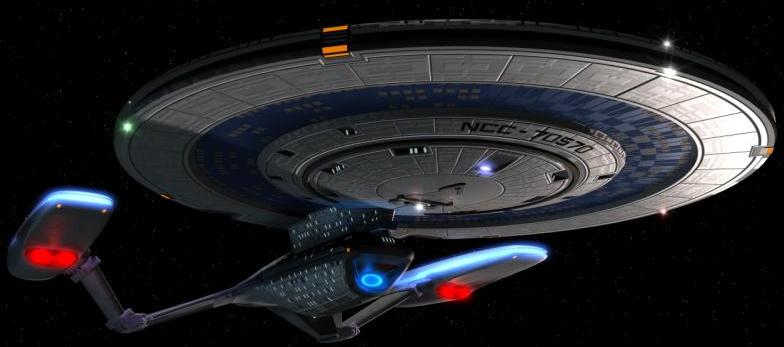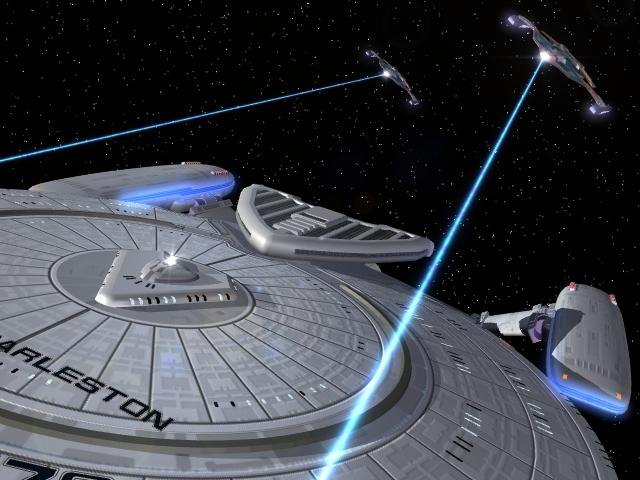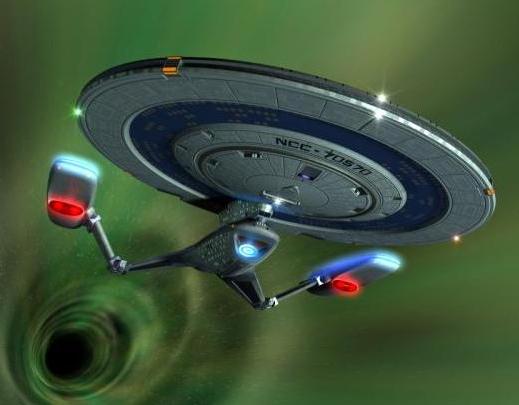+Home+
+Rules+
+Open Positions+
+Character Biographies+
+Join+
+Ship Database+
+Links+

Designed to be a fast, powerful battleship, the Charleston class ship is one of Starfleet's best unknown designs. First designed in the 2350s, the class went though many design changes before she was ever off the drawing board. In 2372, the first ship of the class was built. Quietly, she made a name for herself and the class until her destruction in 2373 against the Borg at Earth. Since, twelve more of the class have been built, the last of which was named USS Charleston-A, after both the class's lead ship and a Saber Class vessel named Charleston that server Starfleet from 2374-2376.

With many threats still facing the Federation after the Dominion war, coupled with exploration duties, the Charleston class ship is capable of preforming both duties. Integrated into her are systems designed for the Sovereign, Galaxy Dreadnought, Nebula, and Intrepid class. Capable of warp speed in excess of warp 9 thanks to her variable geometry, prototype nacelles, she is one of Starfleet's fastest ships. With Type-XII phasers, an arsenal of torpedoes, ablative armor, and powerful shielding, the Charleston class enhances Starfleet's new battle fleet dramatically.

2354: Starfleet issues a general design brief for a multi purpose vessel capable of Deep Space missions, combat, and diplomatic missions. The general idea is for a modular starship. Two project briefs are handed to Starfleet for the Grainger and Charleston Classes. The Grainger Class is rejected by Starfleet. Permission for base designs are approved on the Charleston Class.
2355: Starfleet views the theoretical proposals for the Charleston based on the defense parameters. The initial designs are deemed unsatisfactory and even unsafe by the ASDB. Redesigns are required.
2364: After nine years of redesigns, changes, and deliberation the Charleston's primary design is approved and briefs for the propulsion, computer, weapons and spaceframe parameters are sent out to Starfleet design agencies for consultation. Propulsion dynamics, including variable geometry nacelles based on the working designs for the Intrepid project and prototype nacelles are approved and sent to the Jupiter Station for in-depth study. Spaceframe design is approved and full specifications are forwarded to the Antaries Ship Yard for designations.
2365: USS Charleston production begins with a projected 7 year turnover for the prototype. Design team use Sovereign warp coils and a Galaxy Class warpcore for the prototype. The primary hull begins construction. M/ARA design is standardized for the Class.
2367: Primary hull 65% completion. Computers are delivered for fitting work. Jupiter Station sends new nacelle design, projected to aid the warp field by 17% as well as approves variable geometry nacelles. These are fitted to the frame.
2368: Work continues on habitat and outer hull sections. Late in year computer cores are activated and ship functions begin to be transferred from Station Control to ship control. Nebula Class sensor/weapons pod adapted for the class. Weapons are removed and the pod becomes the primary sensor housing for the ship.
2369: Computer system now operating at 70% of maximum. System expected to become self aware within the year. Warpcore begins primary testing. Antimatter regulation control is found to be outside acceptable levels. Primary magnetic containment malfunction found to be a problem. Design team works on a solution for 9 months, finally finding a solution. Primary hull 100% complete bridge module attached.
2370: Warp core passes Review Three and it tested to 90% peak. Computer system fully self aware and umbilical from the station are cut as the ship become self sufficient. Impulse systems pass Review Three and being autonomous low level power control. Secondary backup generators are shut down and become auxiliary system control. Weapons systems installed. USS Charleston leaves Dry Dock for primary testing.
2372: USS Charleston returns to Antaries early in year. Warp Stress Coating is applied and USS Charleston begins Deep Space assessments.
USS Charleston returns to the Antaries Shipyards for final exterior markings and paint. On 2, November 2372 the USS Charleston is officially commissioned by Starfleet during a brief ceremony. Bridge plaque is put in pride of place and Andorian Captain Atchek takes command. USS Charleston is ordered to begin shakedown cruise estimate to last one year.


expected duration: 120 years
time between resupply: 1 years
time between refit: 5 years
category: Long Range Explorer/Battlecruiser
Naceles: 2 (Variable geometry - pivot up to increase
speed during warp)
Speed:
standard cruise velocity: Warp 7.00
maximum cruise velocity [36 hours]: Warp 9.10
emergency velocity [12 hours]: Warp 9.91
Personnel:
officers: 200
enlisted crew: 450
marines: 146
civilians: 50
Auxiliary Craft:
shuttle bays: 3
shuttles: 14
2 type-8 personal shuttles
2 type-9 personal shuttles
2 type-10 cargo shuttles
2 type-11 personal shuttle
2 type-18 shuttle pods
attack fighters: 6
6Razor Class
runabouts: 5
1Blackhawk Class runabout
1 Danube Class runabout
1 Repulse Class runabout
1 Delta Flyer
1 Warhammer

Weaponry:
phasers:
14 type-XII phaser
arrays
torpedoes:
launchers: 4 ( 2 forward, 2 aft )
photon: 250
quantum: 250
hellfire: 40
transphaisic: 6
tri-cobalt: 10
shields:
ablative armor on hull
MLSS
Klingon cloaking device: hull conformal
Dimensions:
height: 125 meters
width: 342 meters
length: 550 meters
decks: 35
